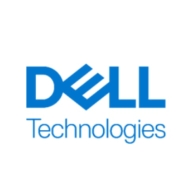


HPE Nimble Storage and Dell PowerMax are prominent enterprise storage solutions in the competitive storage market. While Dell PowerMax is known for its superior features offering unmatched performance, HPE Nimble Storage is preferred for its budget-friendly pricing and excellent support, appealing to cost-conscious buyers.
Features: HPE Nimble Storage excels in ease of setup and management, relying heavily on its Web UI and InfoSight analytics for detailed insights. Dell PowerMax distinguishes itself with advanced features such as superior compression, effective deduplication, and robust high availability, catering to users with high performance requirements.
Room for Improvement: HPE Nimble Storage would benefit from improved data deduplication efficiency and better file-level protocol support. Dell PowerMax could enhance its offerings by addressing its high price and simplifying the integration of NVMe-over-Fabric for better market competitiveness.
Ease of Deployment and Customer Service: Both HPE Nimble Storage and Dell PowerMax deliver strong deployment capabilities for hybrid and on-premises environments. HPE Nimble Storage is highly regarded for its simplicity and proactive support through InfoSight, automating significant portions of the support process. Dell PowerMax is credited with robust support, although additional training resources and a more straightforward management interface would be beneficial.
Pricing and ROI: HPE Nimble Storage is appealing for its all-inclusive pricing, beneficial for organizations focusing on cost management. It offers value through simplified management and less downtime, ensuring a solid ROI. Dell PowerMax, despite its higher price, offers considerable ROI due to its exceptional performance, minimizing the need for extensive infrastructure and ideal for environments with high demand.
If you wait more than seven years to buy another one, you get a return on your investment.
During a DCDR setup and migration from VMAX to Dell PowerMax, what was planned as a two-day downtime was completed in just three to four hours.
The performance metrics or benchmarks I use to measure success with Dell PowerMax include uptime as well as our response times on our platforms, both of which are exactly where we want them to be, which is five nines and as fast as possible.
My client has seen significant ROI since the install, and when you don't go down, that's an ROI in and of itself.
Customers always have their issues resolved promptly.
Technical support is good at least through vendors, not directly with the principal.
I would rate Dell PowerMax support as a ten, as I have never had an issue with Dell support as it relates to this product.
ProSupport Next Business Day offers part replacement within four hours for data leaks.
Dell support for Dell PowerMax is exceptional, rating a perfect 10 out of 10.
They are very fast in resolving any issues.
It hasn't broken down anytime in the last six to seven years, despite hurricanes, earthquakes, and power outages.
Scalability is not an issue.
Dell PowerMax is good for enterprises, and it also depends on how much workload you're going to bring in on Dell PowerMax in terms of performance and how many users are going to use the database you're hosting.
PowerScale is better suited for AI and overall buzz solution currently.
It can adapt to our customers' needs very well.
There are no issues with performance and latency.
I would rate the stability of the product at seven out of ten.
These patches can be applied on the fly without requiring software upgrades or system downtime.
I would rate it nine out of ten since there are no required downtimes, even during firmware upgrades.
There has been no downtime with Dell PowerMax; it's been extremely reliable, easy to manage, easy to upgrade, and trustworthy as we've upgraded over the years from one version to another.
Support resolves problems normally within one or two hours, which is very good.
Sometimes their first and second-tier engineers cannot solve the problem effectively and need to escalate to the third-tier engineer.
One way to improve the product is to add an operational assistant that doesn't depend on VMware.
I would like to see some AI features that would allow arrays to intelligently identify threats or unusual behavior in the data pattern and give an alert.
Storage replication should be essential.
Compared to competitors such as NetApp, which integrates with public cloud hyperscalers (GCP, Azure, AWS), Dell PowerMax lacks in this aspect.
Dell can assist by providing plug-and-play integrated templates that allow customers to drag, drop, modify, and connect with any target system for generating snapshots without logging into the storage directly.
Dell PowerMax NVMe is very reliable storage and cannot experience downtime.
I can't activate the system without a cloud connection, which is a bit laggy if I don't have the right firewall settings, making it take longer to implement the storage.
Currently, customers need to buy everything together to update, and a little more flexibility would be good for both the customer and the reseller.
While the prices may be higher than those of other vendors, we see it as a market leader with benefits.
The support can be a bit pricey, but the solution is more cost-effective than anything else out there.
The higher cost compared to other vendors is justified by additional features, vendor-managed upgrades, and superior support services.
It is the best choice for large projects in terms of price and features compared to midrange solutions.
The price is starting from $500,000.
Other storage companies are very expensive, similar to HPE Storage.
Its data compression feature is the best that we have ever seen.
Pure FlashArray X NVMe helps to improve our processing speed.
We are satisfied with the performance as it is significantly faster compared to traditional storage options.
NVMe provides additional fast cache, similar to random access memory (RAM), which improves overall system performance and read/write experience for users.
Dell PowerMax NVMe is very supportive of our operational growth since we require daily performance from our core banking systems and need to facilitate data movement efficiently.
The key benefits of using Dell PowerMax, quantified in terms of saved hours and saved costs, is having one single platform that provides functionality to all of our internal customers.
It's very fast and simple to implement for us as a system integrator.
The positive aspects of HPE Nimble Storage include very easy cloud management to identify problems, and it also has the capability to forecast performance in the future.
| Product | Market Share (%) |
|---|---|
| Dell PowerMax | 4.8% |
| HPE Nimble Storage | 2.4% |
| Pure FlashArray X NVMe | 1.4% |
| Other | 91.4% |


| Company Size | Count |
|---|---|
| Small Business | 15 |
| Midsize Enterprise | 11 |
| Large Enterprise | 12 |
| Company Size | Count |
|---|---|
| Small Business | 17 |
| Midsize Enterprise | 15 |
| Large Enterprise | 55 |
| Company Size | Count |
|---|---|
| Small Business | 47 |
| Midsize Enterprise | 42 |
| Large Enterprise | 40 |
Pure Storage FlashArray//X is the world’s first enterprise-class, all-NVMe flash storage array. It represents a new class of storage – shared accelerated storage, which is a term coined by Gartner – that delivers major breakthroughs in performance, simplicity, and consolidation.
PowerMax leads in mission-critical enterprise storage with advanced architecture and AI-driven automation, ensuring secure and efficient IT optimization. Its multi-node NVMe scale-out framework delivers unmatched performance and consolidation, backed by Dell’s Future-Proof Program.
PowerMax is renowned for its robust reliability, performance, and efficient data reduction capabilities. Users benefit from its NVMe architecture, aiding significant scalability and cost efficiency through effective deduplication and compression. Unisphere simplifies management, while CloudIQ provides enhanced monitoring. With high availability and strong IOPS capabilities, PowerMax effectively manages demanding workloads and ensures seamless operations. Its compact design and increased storage capacity enhance user experience, particularly with easy maintenance and robust performance.
What are the key features of PowerMax?Dell PowerMax is predominantly employed in mission-critical applications such as SQL, Oracle databases, ERP systems, and high transactional environments. Healthcare, finance, and e-commerce sectors leverage its high performance, scalability, and NVMe technology for low latency and redundancy. It is adept in storage consolidation, data analytics, and disaster recovery.
HPE Nimble Storage is a highly effective All-Flash Storage Array solution that aims to enable organizations to reliably store and access their data. Organizations across a wide variety of industries trust Nimble Storage to assist them with all of their data storage-based needs. It both tracks all of the IT architecture that an organization uses and protects that architecture from a variety of digital threats.
HPE Nimble Storage Benefits
Some of the ways that organizations can benefit by choosing to deploy HPE Nimble Storage include:
HPE Nimble Storage Features
Reviews from Real Users
HPE Nimble Storage is a highly effective solution that stands out when compared to many of its competitors. Two major advantages it offers are its ease of use and its powerful InfoSight analytics feature.
Andrew B., Head Of Information Technology at Zambia National Building Society, writes, “It's a very easy solution. Whenever I have a question, I find they have already provided a solution for it.”
Prataparao D., Technical Solution's Consultant for HPE Storage Devices at Karvy Innotech, says, “HPE Nimble Storage uses the InfoSight platform and it is useful because we can identify the faults and can analyze the performance. It has many other features. This feature is the best that I have observed from HPE Nimble Storage.”
We monitor all All-Flash Storage reviews to prevent fraudulent reviews and keep review quality high. We do not post reviews by company employees or direct competitors. We validate each review for authenticity via cross-reference with LinkedIn, and personal follow-up with the reviewer when necessary.